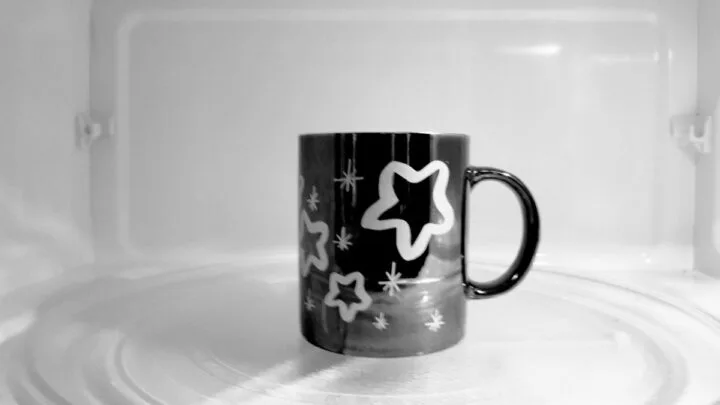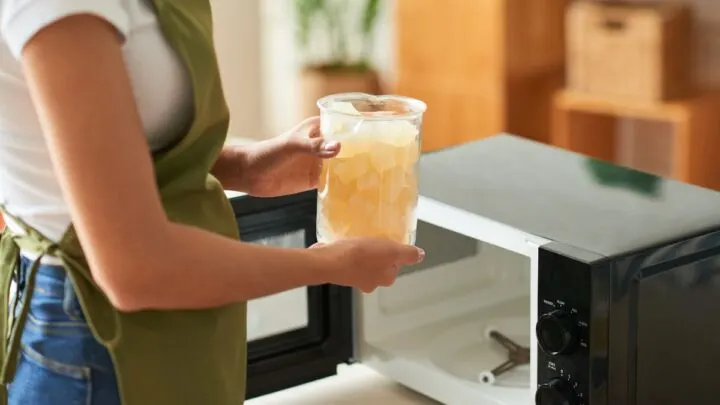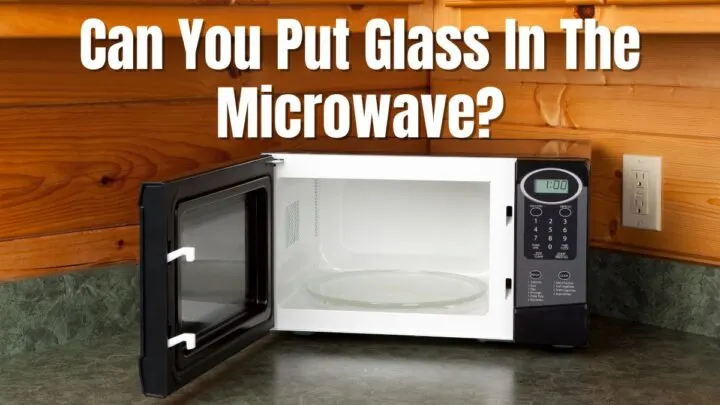With the evolution of technology, life has never been easier.
Whether it’s reheating leftover pizza within seconds or a tired adult reheating their meal preps, the microwave is undoubtedly one of the most useful appliances in the kitchen..
However, not anything and everything can be safely reheated in a microwave oven, especially glassware.
Although reheating leftovers is most secure (and maybe your safest bet) in glass dishes, since neither styrofoam or plastic to-go containers can be heated in a microwave, there are still certain rules to microwaving glass that you need to be aware of.
You can put glass in the microwave if the glassware is designated as “microwave safe.”This indicates that the glass is built to withstand extreme temperatures.
That being said, let us take a deeper look at all the details you should be aware of before putting your glass in a microwave oven.

Which Types Of Glass Are Not Microwaveable?
Typically, glass is a very durable material that is also a good conductor of heat, therefore it can easily be placed in a microwave oven, fridge or even a freezer.
There aren’t any complex rules when it comes to heating glass in a microwave.
The two types of glasses that are found in almost every household are natural or conventional synthetic glasses.
Both are generally regarded as safe for heating in the microwave.
However, any item that is not marked as “microwave-safe” or if the symbol is not found and fails the microwave test described below, should not be used to reheat food in a microwave oven.
The reason why certain glass is marked unsafe is due to the possibility that the glassware contains metal, colours, or air bubbles that might cause the glass to shatter or break in the microwave.
Furthermore, you should also not microwave glass food containers or drinking glasses with plastic seals.
What Is The Microwave Test?
The best way to know if your glass is microwavable is to look for a tiny figure depicting zigzag lines at the back of any glass.
We even recommend looking for this symbol on anything you wish to heat in a microwave.
However, most of the time, especially in cases of certain old glassware, this symbol may not always be found.
That’s where the microwave test comes in, which is as follows:
- Pour a cup of cold water into your glass dish.
- Heat it in the microwave for 1 or 2 minutes
- Next, take a temperature reading of the glass dish by carefully touching it.
- If it is extremely hot, the glassware is not suitable for microwaving.
- The dish is probably okay to microwave if it’s only slightly warm or even lukewarm but the water within has been heated.
However, refrain from doing this with thin glassware as it is at a greater risk of breaking from the test.
And don’t forget to use caution as you move forward with the test.
Can Glass Melt In A Microwave?
Although glassware that is not microwave-safe is prone to breaking or shattering, melting is quite unlikely.
Depending upon the type of glass, the general melting point of the glass is either 900 degrees or even up to 1600 degrees Fahrenheit.
That much heat cannot be produced by standard microwaves in any amount of time.
The worst that a standard microwave can do to your glassware is explode it. This is all due to the minute air bubbles contained in a glass container.
So as long as you use a microwave-safe container, you won’t have to worry about the glass melting if you microwave it!
Can I Microwave A Cold Glass?
Now you may be wondering, will your glassware shatter if it is heated while it is cold?
Typically, conventional synthetic and natural glass containers, as long as they have been tempered before heating, can be used in the microwave at room temperature or slightly chilled (recently refrigerated) temperatures.
However, it is completely understandable to not have the time (or even patience) to wait for your delicious food-filled glassware to warm up.
In this case, the best advice is to use microwave-safe glass as not only are they chemically inert, which helps prevent it from reacting with the food but also is highly resistant to heat- therefore saving you from a broken glass mess!
Glass containers designed for microwave use don’t include microscopic air bubbles or metal decorations as other glass containers do.
When heated, the air bubbles in non-microwave safe materials may expand.
Therefore, as explained above, the glass may break if the air in bubbles expands to a certain degree.
This makes recently chilled, microwave-safe glass with light to moderate condensation suitable for medium power heating in a microwave.
However, you don’t have to wait for the condensation to evaporate if you use a low to medium power setting.
But most importantly, it is crucial to keep in mind that frosty frozen microwave-safe containers should be thawed first before being heated in the microwave at any temperature.

How To Microwave Cold Glass?
As mentioned above, heating extremely cold glassware can end in its shattering.
Hence for your safety and to save your beloved food, it is necessary that you know how to warm your food properly if you are in a hurry.
It is quite easy to heat your microwave-safe glass containers in the microwave, even if they are a bit chilly.
You can easily heat them as much as you want given that you increase the temperature slowly.
However, it must be ensured that the glass is not too cold and they are not left inside for an extended period.
Therefore, all you need to do is heat the glassware for a few minutes before mixing the contents of the glass and then continue to heat it.
Mixing the contents allows the heat to distribute evenly among the food without leaving any cold spots.
Final Word On Putting Glass in the Microwave
All in all, while it may seem tempting to straightaway reheat your cold glass dish, it is best to practice patience and follow the above information to prevent any mishaps.
Also, don’t forget to use only microwave-safe glasses if you do end up heating your glassware in a microwave oven, especially when it is cold.


